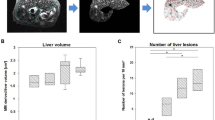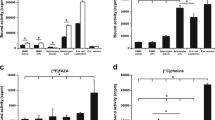Abstract
Purpose
The aim of this study is to explore the feasibility of 11C-Choline PET in the assessment of the degree of inflammation in the Chlamydia muridarum genital infection model.
Procedures
Forty female Balb/c mice received 2.5 mg of medroxyprogesterone acetate i.m. 9 and 2 days prior to the infection: 21 mice were infected by C. muridarum into the vaginal vault, 12 mice were treated with inactivated chlamydiae, and 7 mice were SPG buffer-treated as negative controls. Three healthy control mice were not treated with progesterone. Mice in each category were randomly subdivided in two groups: (1) sacrificed at 5, 10, 15, and 20 days for histological analysis and (2) undergoing 11C-Choline PET at days 5, 10, and 20 post-infection (20 MBq of 11C-Choline, uptake time of 10 min, acquisition through a small-animal PET tomograph for 15 min).
Results
Infected animals showed a significantly higher standardized uptake value than both controls and animals inoculated with heat-inactivated chlamydiae in each PET scan (P < 0.05). All organs of the infected animals had scores of inflammation ranging between 2 and 3 at day 5, decreasing to 1–2 at day 20.
Conclusions
This preliminary result demonstrated that 11C-Choline PET can highlight a specific proliferation mechanism of inflammatory cells induced by C. muridarum, thanks to a very high sensitivity in detecting very small amounts of tracer in inflammatory cells.



Similar content being viewed by others
References
Beagley KW, Timms P (2000) Chlamydia trachomatis infection: incidence, health costs and prospects for vaccine development. J Reprod Immunol 48:47–68
Paavonen J, Eggert-Kruse W (1999) Chlamydia trachomatis: impact on human reproduction. Hum Reprod Update 5:433–447
Rein DB, Kassler WJ, Irwin KL, Rabiee L (2000) Direct medical cost of pelvic inflammatory disease and its sequelae: decreasing but still substantial. Obstet Gynecol 95:397–402
Sweet RL, Gibbs RS (2009) Pelvic inflammatory disease. In: Sweet RL, Gibbs RS (eds) Infectious diseases of the female genital tract. Lippincott, Philadelphia, pp 220–244
Sweet RL (2012) Pelvic inflammatory disease: current concepts of diagnosis and management. Curr Infect Dis Rep 14(2):194–203
Sweet RL (2011) Treatment of acute pelvic inflammatory disease. Infect Dis Obstet Gynecol. doi:10.1155/2011/561909
Darville T, Hiltke TJ (2010) Pathogenesis of genital tract disease due to Chlamydia trachomatis. J Infect Dis 201(suppl 2):114–125
Kiviat NB, Wolner-Hanssen P, Eschenbach DA et al (1990) Endometrial histopathology in patients with culture-proved upper genital tract infection and laparoscopically diagnosed acute salpingitis. Am J Surg Pathol 14:167–175
Miyairi I, Ramsey KH, Patton DL (2010) Duration of untreated chlamydial genital infection and factors associated with clearance: review of animal studies. J Infect Dis 201(suppl 2):96–103
Bell JD, Bergin IL, Schmidt K et al (2011) Nonhuman primate models used to study pelvic inflammatory disease caused by Chlamydia trachomatis. Infect Dis Obstet Gynecol. doi:10.1155/2011/675360
Nelson DE, Virok DP, Wood H et al (2005) Chlamydial IFN-gamma immune evasion is linked to host infection tropism. Proc Natl Acad Sci U S A 102:10658–10663
Barron AL, White HJ, Rank RG, Soloff BL, Moses EB (1981) A new animal model for the study of Chlamydia trachomatis genital infections: infection of mice with the agent of mouse pneumonitis. J Infect Dis 143:63–66
Stephens RS, Kalman S, Lammel C et al (1998) Genome sequence of an obligate intracellular pathogen of humans: Chlamydia trachomatis. Science 282:754–759
Cho HJ, Kim HK, Suh JH et al (2008) Fitz-Hugh–Curtis syndrome: CT findings of three cases. Emerg Radiol 15:43–46
Jaiyeoba O, Soper DE (2011) A practical approach to the diagnosis of pelvic inflammatory disease. Infect Dis Obstet Gynecol. doi:10.1155/2011/753037
Nanni C, Marangoni A, Quarta C et al (2009) Small animal PET for the evaluation of an animal model of genital infection. Clin Physiol Funct Imaging 29:187–192
Zeisel SH (1993) Choline phospholipids: signal transduction and carcinogenesis. FASEB J 7:551–557
Nanni C, Fantini L, Nicolini S, Fanti S (2010) Non FDG PET. Clin Radiol 65:536–548
Torizuka T, Kanno T, Futatsubashi M et al (2003) Imaging of gynecologic tumors: comparison of (11)C-choline PET with (18)F-FDG PET. J Nucl Med 44:1051–1056
Wyss MT, Weber B, Honer M et al (2004) 18F-choline in experimental soft tissue infection assessed with autoradiography and high-resolution PET. Eur J Nucl Med Mol Imaging 31:312–316
Roivainen A, Parkkola R, Yli-Kerttula T et al (2003) Use of positron emission tomography with methyl-11C-choline and 2-18F-fluoro-2-deoxy-D-glucose in comparison with magnetic resonance imaging for the assessment of inflammatory proliferation of synovium. Arthritis Reum 48:3077–3084
Matter CM, Wyss MT, Meier P et al (2006) 18F-choline images murine atherosclerotic plaques ex vivo. Arterioscler Thromb Vasc Biol 26:584–589
Laitinen IE, Luoto P, Någren K et al (2010) Uptake of 11C-choline in mouse atherosclerotic plaques. J Nucl Med 51:798–802
Kato K, Schober O, Ikeda M et al (2009) Evaluation and comparison of 11C-choline uptake and calcification in aortic and common carotid arterial walls with combined PET/CT. Eur J Nucl Med Mol Imaging 36:1622–1628
Donati M, Sambri V, Comanducci M et al (2003) DNA immunization with pgp3 gene of Chlamydia trachomatis inhibits the spread of chlamydial infection from the lower to the upper genital tract in C3H/HeN mice. Vaccine 21:1089–1093
Pascali G, D'Antonio L, Bovone P et al (2009) Optimization of automated large scale production of [(18F)]fluoroethylcholine for PET prostate cancer imaging. Nucl Med Biol 36:569–574
Marangoni A, Donati M, Cavrini F et al (2006) Chlamydia pneumoniae replicates in Kupffer cells in mouse model of liver infection. World J Gastroenterol 12:6453–6457
Wiesenfeld HC, Hillier SL, Krohn MA et al (2002) Lower genital tract infection and endometritis: insight into subclinical pelvic inflammatory disease. Obstet Gynecol 100:456–463
Wiesenfeld HC, Sweet RL, Ness RB et al (2005) Comparison of acute and subclinical pelvic inflammatory disease. Sex Transm Dis 32:400–405
Nishie A, Yoshimitsu K, Irie H et al (2003) Fitz-Hugh–Curtis syndrome. J Comput Assist Tomogr 27:786–791
Tsujikawa T, Tsuchida T, Yoshida Y et al (2011) Role of PET/CT in gynecological tumors based on the revised FIGO staging classification. Clin Nucl Med 36:114–118
Hashefi M, Curiel R (2011) Future and upcoming non-neoplastic applications of PET/CT imaging. Ann N Y Acad Sci 1228:167–174
Henriksen G, Herz M, Hauser A et al (2004) Synthesis and preclinical evaluation of the choline transport tracer deshydroxy-[18F]fluorocholine ([18F]dOC). Nucl Med Biol 31:851–858
Conflict of interest
None
Author information
Authors and Affiliations
Corresponding author
Rights and permissions
About this article
Cite this article
Marangoni, A., Nanni, C., Quarta, C. et al. Usefulness of 11C-Choline Positron Emission Tomography for Genital Chlamydial Infection Assessment in a Balb/c Murine Model. Mol Imaging Biol 15, 450–455 (2013). https://doi.org/10.1007/s11307-013-0612-4
Published:
Issue Date:
DOI: https://doi.org/10.1007/s11307-013-0612-4




